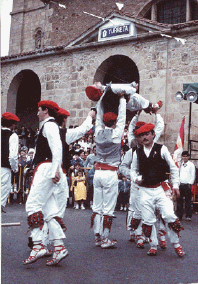| BASIC CONCEPTS |
 |
Confining ourselves to the different types of dance preserved in the Basque Country we cannot overlook three characteristic forms: the romerías, or open-air dances, sword dances and end of festival dances.
| THE ROMERIAS OR OPEN-AIR DANCES |
 |
 |
Confining ourselves to the different types of dance preserved in the Basque Country we cannot overlook three characteristic forms: the romerías, or open-air dances, sword dances and end of festival dances.
| SWORD DANCES |
 |
 |

Photo: Performance of the dance known as Txotxongiloa ("The Puppet Dance"), as part of the Dantzari Dantza programme at the fiesta of San Miguel in Iurreta (Bizkaia).
On the other hand, the sword dances, some of which were already mentioned above in the section on Dantzari Dantza, are diversified and their relation with European dances of the same type is obvious. The Ezpata Dantza from Gipuzkoa, as well as the version of the same dance from the town of Zumarraga, or Legazpi or Xemein all give witness to the use of swords. The Makil gurutze from Lesaka, the San Roke Dantza from Deba and the Bordon Dantza from Tolosa are a combination of the ceremonial and festive use of ritual dance, without forgetting the participation, respect and support by the rest of the town of each dance group.
| END OF FESTIVAL DANCES |
 |
 |
The third group of dances comprises the dances that wrap up feast days and Carnival festivities. These days have been handed down to us in certain areas of the Basque Country. The Jorrai Dantzak (weeding hoe dances) and Zaragi Dantzak (wineskin dances) in Arano, Markina, Goizueta, Mutriku, Deba and Oikia serve as a symbolic ending to the wild festivities with their beating and thrashing and burning of the swollen yet empty wineskin. It is the end of one cycle and the beginning of another.
| CONCLUSIONS |
 |
With this overview, we wish to show that no dances are more important than others. Some are better known than others. Some are more complex, while others are simpler. Some are ritual and others entertaining. Some religious others pagan. Some sacred and other profane. Some are open group dances and others closed. Generally the space in which they are carried out is open, although a few were originally danced in closed quarters. The vast majority are danced only by men, some only by women and others by both sexes.
The basic characteristics of Basque dance can be seen between choreography, historical and festive elements, and the universal traits of tradition, entertainment, tourism and especially religious-festive events.
We can distinguish different forms of representation, but undoubtedly they all belong to the human and social manifestations inherent in each community, as well as idiosyncrasies and popular sentiment and the personalisation of local and family rituals.
Emilio Javier Dueñas
|